
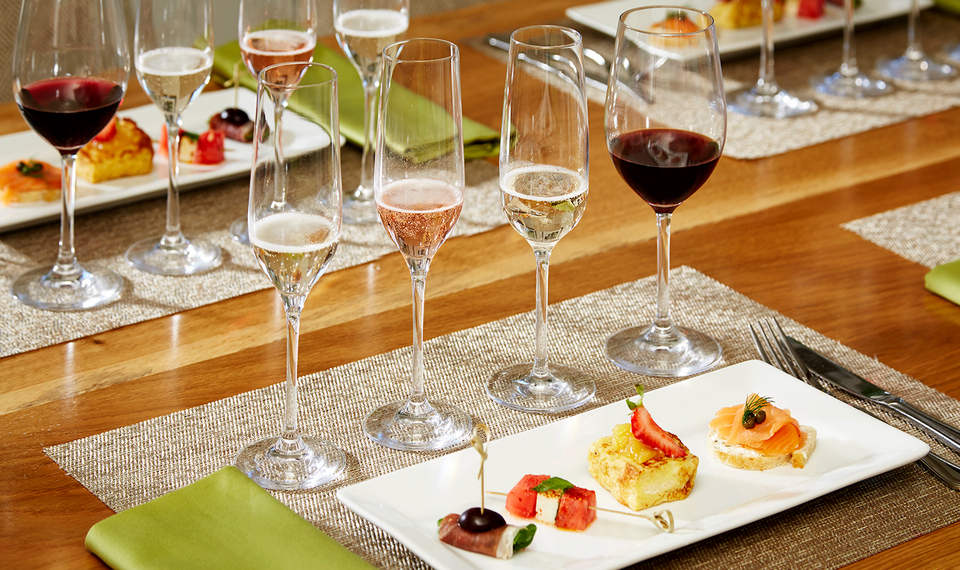
The ultimate goal of pairing food and wine is to increase your enjoyment of the meal so the better you know your preferences, the easier it becomes to make your own pairings.Food and wine paring can be endless fun. Both food and wine are quite complex and the possibilities in pairing the two are unlimited. The old adage, “red wine with red meat; white wine with white meat,” hardly applies to the full spectrum of all the food and wines.
It is no secret that a well-matched wine will enhance the tastes and textures of a dish. Some wines and food pairings are classic, it is almost as if certain wines were designed to accompany a particular food. However, food and wine pairing is subjective, flexible and versatile and the fun comes with experimenting. You can enjoy a Cabernet Sauvignon with a steak. You could also enjoy a Bordeaux, a Burgundy, a Chianti Classico, a Zinfandel or a Rioja Reserva, just to name a few.
The ultimate goal of pairing food and wine is to increase your enjoyment of the meal so the better you know your preferences, the easier it becomes to make your own pairings.
Learn the Rules to Bend the Rules
When you’re in the first steps of learning any new skill, it is useful to know the rules as they provide structure and focus, allowing you to grasp the basics. In the art and science of pairing food and wine, there are no hard-and-fast rules but some basic guidelines can point you in the right direction. Once you understand these basics, you can go ahead and experiment, perhaps bend the rules and be creative to your heart’s content.
Here are some basic guidelines to get you started:
- All flavors are accentuated by harmony or contrast.
- Wine should be sweeter and more acidic than your food, otherwise the wine will taste flabby.
- The wine should have the same flavor intensity as the food.
- Aim to match your wine with the sauce rather than the meat.
- Red wines pair well with rich, bold meats like beef and lamb.
- White wines go well with lighter meats like chicken or fish.
- Bitterness in wines (e.g. red wines) are best balanced with fat.
- Contrasting pairings are best with lighter wines such as rosé, sparkling, and white wines.
- Congruent pairings is best suited with red wines.
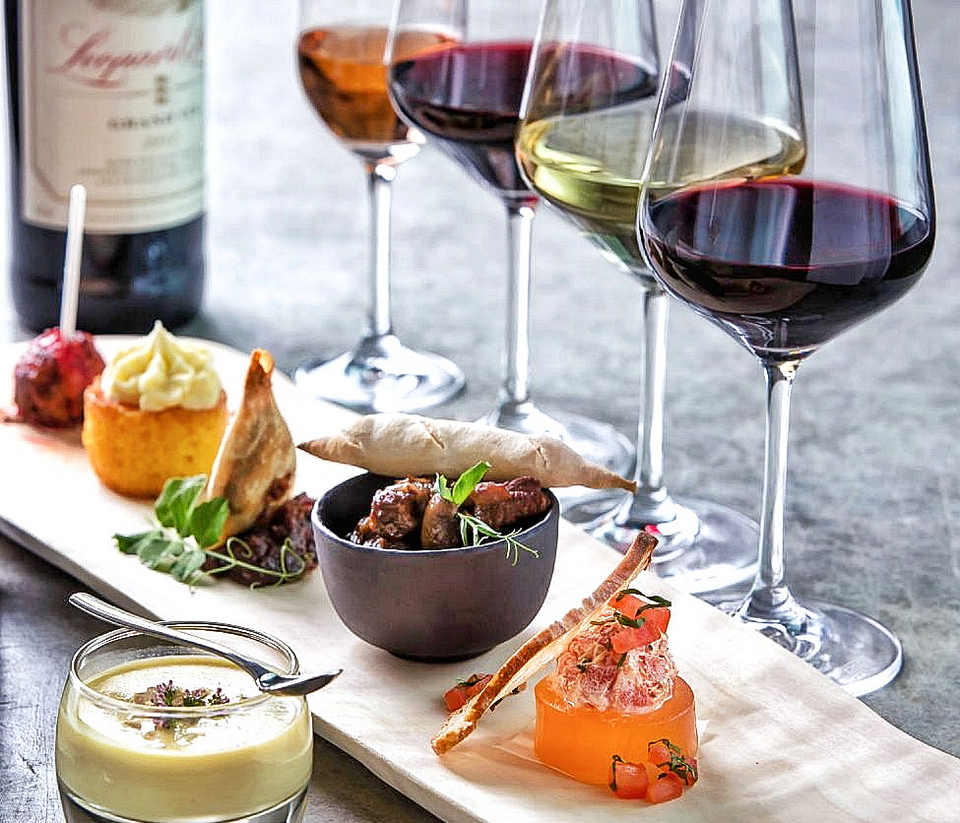 Basics Taste Components in Food
Basics Taste Components in Food
There are several different taste elements identified in food from basic sweet, sour, bitter, to the extreme like umami. When it comes to pairing food with wine, you only need to focus on 6 tastes: salt, acid, sweet, bitter, fat and spice (piquant).
Basic Taste Components in Wine
For the most part, wine lacks the 3 tastes of fattiness, spiciness and saltiness but does contain acidity, sweetness and bitterness in varying degrees. Generally speaking:
- Red wines have more bitterness.
- White, rosé and sparkling wines have more acidity.
- Sweet wines have more sweetness.
The goal in selecting a wine to accompany a meal is to have a balance between the wine and the food. You don’t want the wine to overpower the food or vice versa. You can use two reliable approaches to achieve this. You can select wines to compliment the taste components of the food or to contrast it.
Contrasting vs Congruent Pairings
The principle of contrasting pairings is most common with white and sparkling wines. For example, a dry sparkling wine can bring out the best of a creamy, fatty cheese precisely because the flavor profiles are so distinct from each other. The vast difference in texture and taste is exactly what allows these two to burst into life on your palate.
Meanwhile, congruent pairings is popular with red wine, highlighting shared flavors, just as a rich red wine complements the fatty flavors in a sirloin steak. This congruent pairing is the staple of any steakhouse, a meaty steak paired with a bold glass of full-bodied red for company.
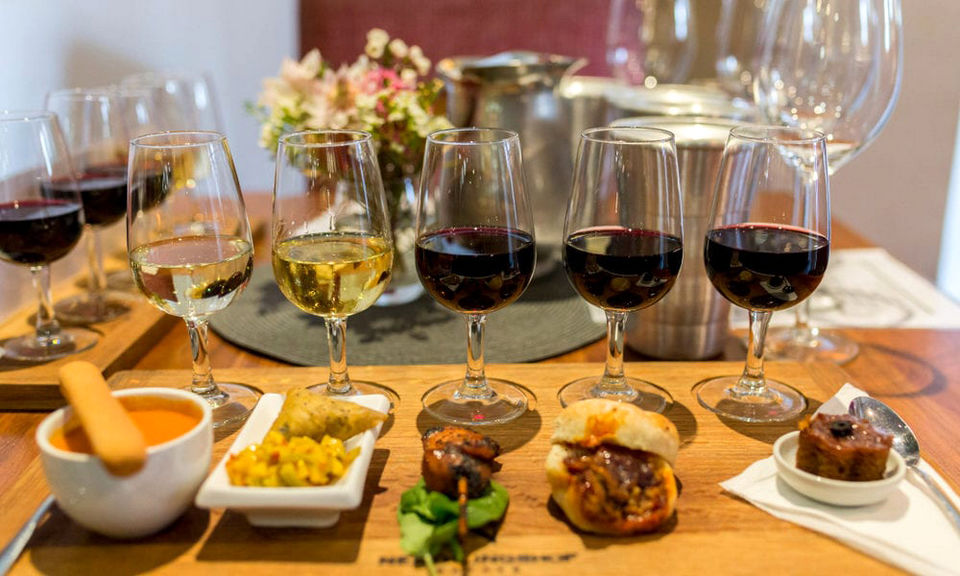 The Intensity
The Intensity
Is the food light or rich? A salad may seem lighter, but perhaps the dressing is balsamic vinaigrette with high acidity. If the intensity of the dish isn’t obvious at first, just focus on the power of each taste component; acidity, fattiness, sweetness, etc.
Is the wine light or bold? Here are a few examples:
Sauvignon Blanc is light-bodied, but it has higher acidity.
Chardonnay has more body, but it’s usually not too acidic.
For a red wine, Pinot Noir is lighter bodied and it doesn’t have too much tannin (bitterness).
Cabernet Sauvignon is more full-bodied and has high tannin (more bitterness).
Body
The body is the actual weight of a wine that you feel in the mouth, not the taste. Light bodied wines are comparable to the feel of skim milk in your mouth; full-bodied wines feel more like cream. In terms of body, it makes sense to pair light-bodied wines with lighter food, and full-bodied wines with heartier food. For this reason, full-bodied whites, such as Chardonnay, often do not pair well with delicate seafood, and lighter reds, such as Beaujolais, don’t do justice to a hearty steak but will pair well with chicken or pork.
Tannins
Tannins are a chemical compound present in grape skins, seeds, and stems, as well as in oak barrels and they are especially prominent in red wines. Tannins are also present in some oak-aged white wines. They are a natural preservative and are most prominent in young wines. As wines age, they become mellow and smooth. Tannins taste dry (astringent) and bitter, and have a very particular effect when paired with certain foods. For example, salty foods bring out the bitterness in tannins, and cream-based foods make tannins seem more astringent. Tannic wines pair well with low-salt and high-fat food, like well-marbled meat. When enjoyed together, fat lessens the astringency of tannins, and conversely tannins prevent fat from being too rich.
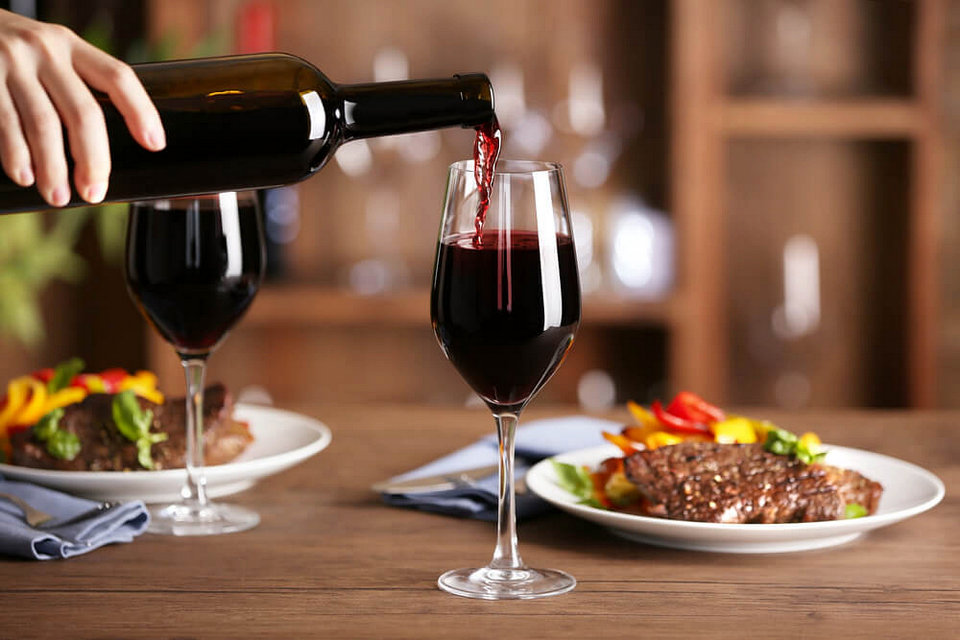 Classic Pairings: Cabernet Sauvignon with steak
Classic Pairings: Cabernet Sauvignon with steak
Acidity
Acidity in wine comes from both the grapes and the fermentation process. There is some degree of acidity in all wines, although it can be overshadowed or masked by tannins. Acidity is most noticeable in wines where tannins are not very prominent. White wines, such as Sauvignon Blanc and Pinot Grigio, often have prominent acidity, which gives them their crispiness. Acidity is also present on low-tannin red wines, such as Beaujolais and Chianti. As a general rule, acidic wines are very food-friendly. Acidic wines pair well with acidic foods, including citrus fruits, tomatoes, and tomato based sauces, as well as rich, creamy foods, as the acidity “cuts through” the richness. They pair particularly well with fish as well as fried foods. The acid in the wine serves the same role as the acid in fresh lemon so often squeezed on these dishes. Acidic wines also often pair well with salty foods, helping to cut the salty taste on the palate. Conversely, low-acid wines often clash with acidic foods and the pairing of the two should be avoided.
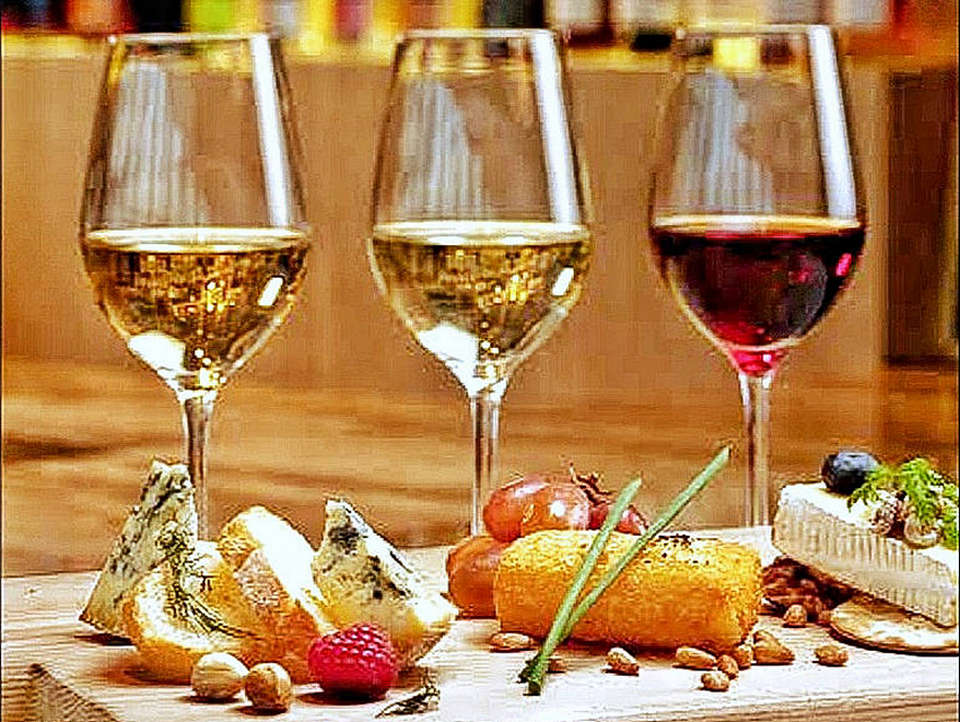 Classic Pairings: Sauvignon Blanc with fish, Chianti with tomato sauce-based pasta
Classic Pairings: Sauvignon Blanc with fish, Chianti with tomato sauce-based pasta
Sweetness
Sweetness in wine is a result of residual sugar that is not converted to alcohol in the wine making process. In an excellent example of contrast, sweet wines are a great match for very spicy or salty foods. However, the sweet flavor of semi-sweet or off-dry wines also pairs well with naturally sweet dishes, such as honey-glazed ham, or pork with a port wine reduction sauce. Sweet wines are also often served alongside desserts. The general rule with sweet and semi-sweet wines is to pair them with foods that are less sweet than the wine itself.
Classic Pairings: Sauternes with foie gras, Riesling with spicy Asian dishes, Sauternes with créme brûlée
Alcohol
The percentage of alcohol in a wine can influence a wine’s ability to pair with certain foods. Cream-based, spicy, or salty foods particularly clash with high-alcohol wines as cream makes alcohol seem stronger; alcohol makes spicy foods seem spicier; and alcohol together with salt can taste bitter. High-alcohol wines often pair well with high-fat dishes, such as steaks, as the fat can lessen the intensity of the alcohol.
 Classic Pairings: Chardonnay with lobster beurre blanc, Zinfandel with barbecued beef
Classic Pairings: Chardonnay with lobster beurre blanc, Zinfandel with barbecued beef
Aroma
Aroma may be the most difficult, as well as the most gratifying component of pairing wine and food. If all other factors of a wine (body, acidity, tannins, sweetness, and alcohol) are harmonious with a dish, a mismatched aroma won’t necessarily hurt a wine pairing; however, if all factors are harmonious and the aromas of the wine match those of the food, the pairing can be elevated from excellent to heavenly. Highly aromatic wines, such as Gewurztraminer and Viognier are often best paired with aromatic dishes, such as those with orange or exotic fruit flavors. Nutty Chardonnays may be ideally suited to roasted nut flavors. Earthy Pinot Noirs pair especially well with wild mushrooms, while peppery Syrah will be dynamic with a peppercorn sauce. Aromas of herbs, spices, fruits, and vegetables in a dish as well as hints of minerality, earthiness, and other notes can all be cues to pairing with wines.
If you are going to be sampling more than one wine over the course of your evening, you should also consider the intensity of the wine. The flavors of wines should become more intense as the evening progresses. In general, aim to enjoy light, fresh wines before luxurious, rich ones; steel-fermented before oak-aged, simple before complex, dry before sweet, and less tannic before more tannic.
Of course, it’s fun to experiment and fine-tune, and with experience you may be able to create spectacular matches that dramatically improve your dining pleasure.
Bon Appetit!
 Ranjith Chandrasiri is a veteran hotelier, food and wine connoisseur, multilinguist with a wealth of knowledge and international hotel management experience in luxury hotels and iconic brands including InterContinental Hotels Group in Europe, Australia, Cambodia, Thailand and Sri Lanka. He is the Chairman of Sirius Hospitality Consulting in Thailand, former Group General Manager of Jetwing Hotels Group, Sri Lanka and Royal Cliff Hotels Group, Thailand, Founder/President of Royal Cliff Wine Club and deVine Wine Club, Bailli Honoraire (Honorary President) of Chaîne des Rôtisseurs, Pattaya, Thailand
Ranjith Chandrasiri is a veteran hotelier, food and wine connoisseur, multilinguist with a wealth of knowledge and international hotel management experience in luxury hotels and iconic brands including InterContinental Hotels Group in Europe, Australia, Cambodia, Thailand and Sri Lanka. He is the Chairman of Sirius Hospitality Consulting in Thailand, former Group General Manager of Jetwing Hotels Group, Sri Lanka and Royal Cliff Hotels Group, Thailand, Founder/President of Royal Cliff Wine Club and deVine Wine Club, Bailli Honoraire (Honorary President) of Chaîne des Rôtisseurs, Pattaya, Thailand
 |
 |
 |





